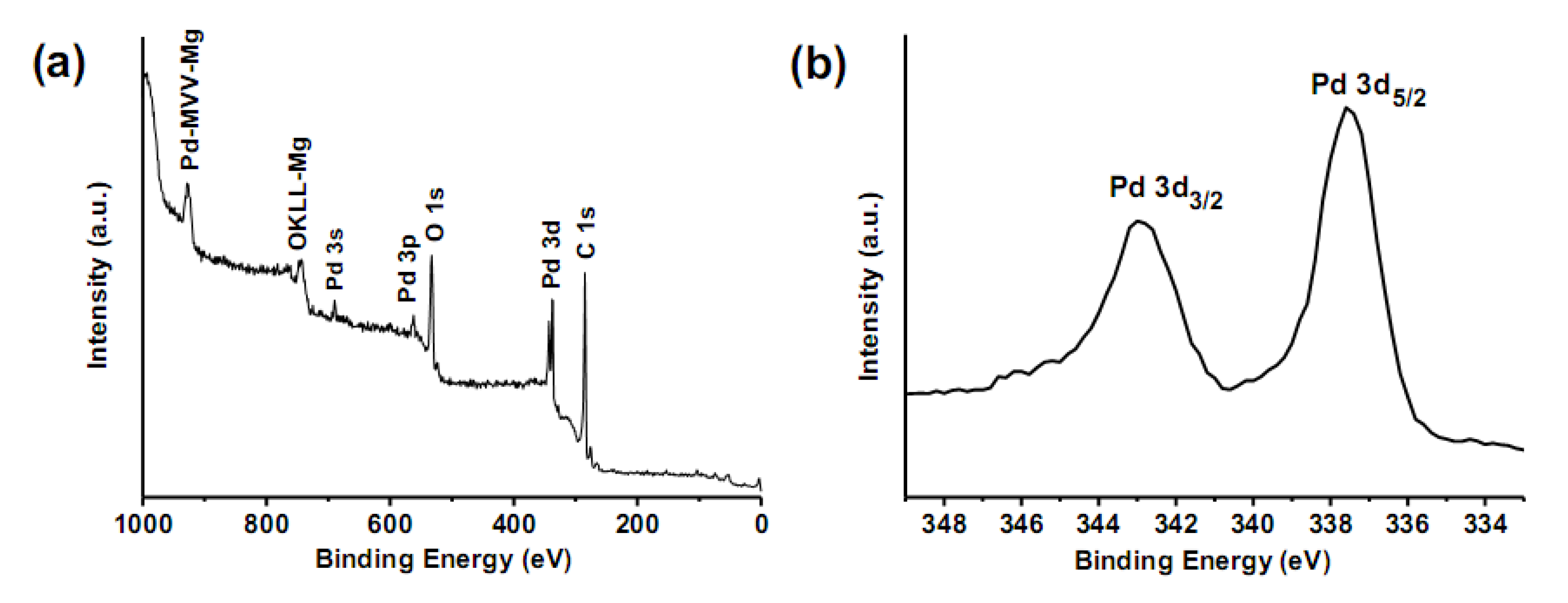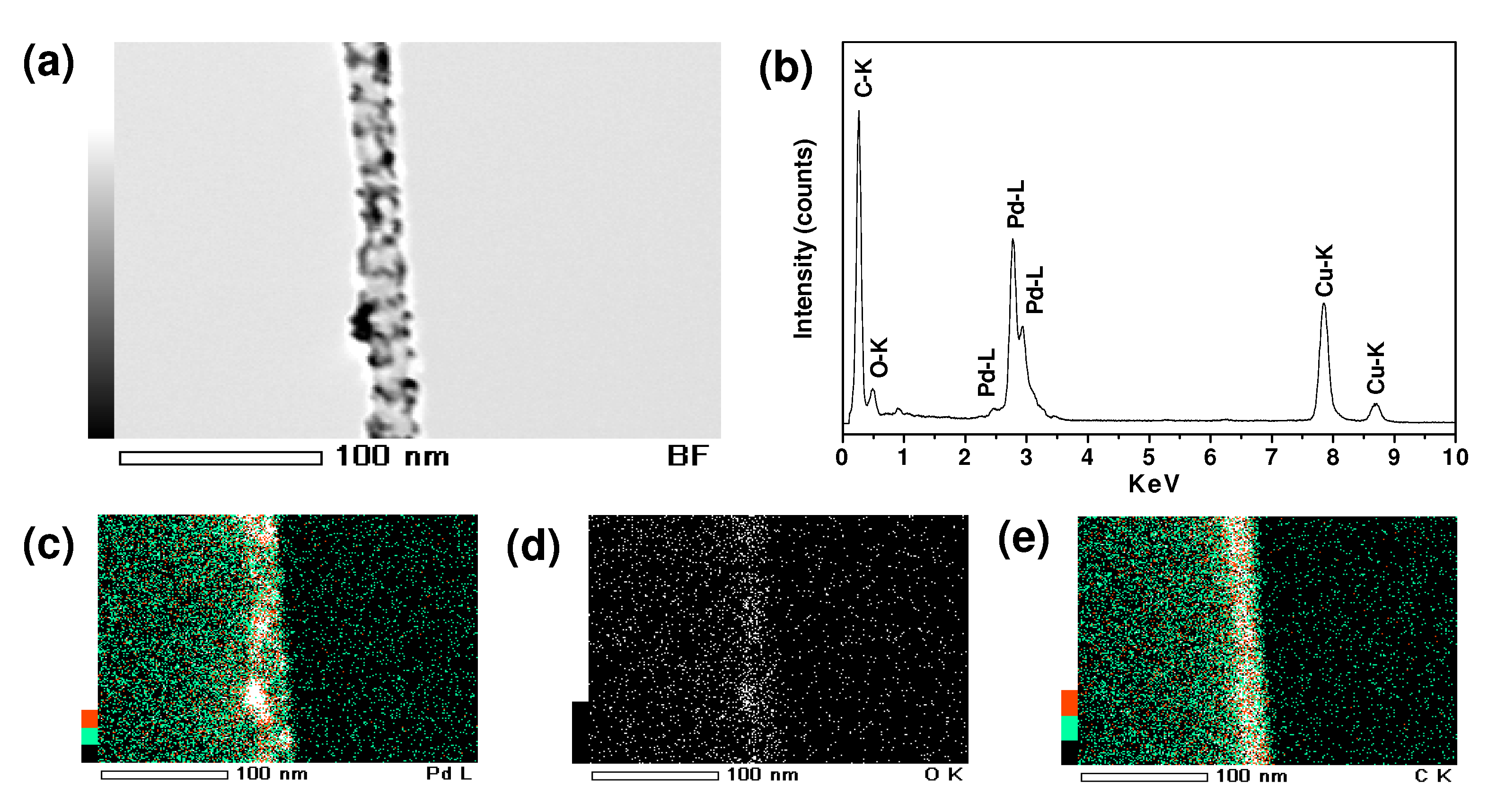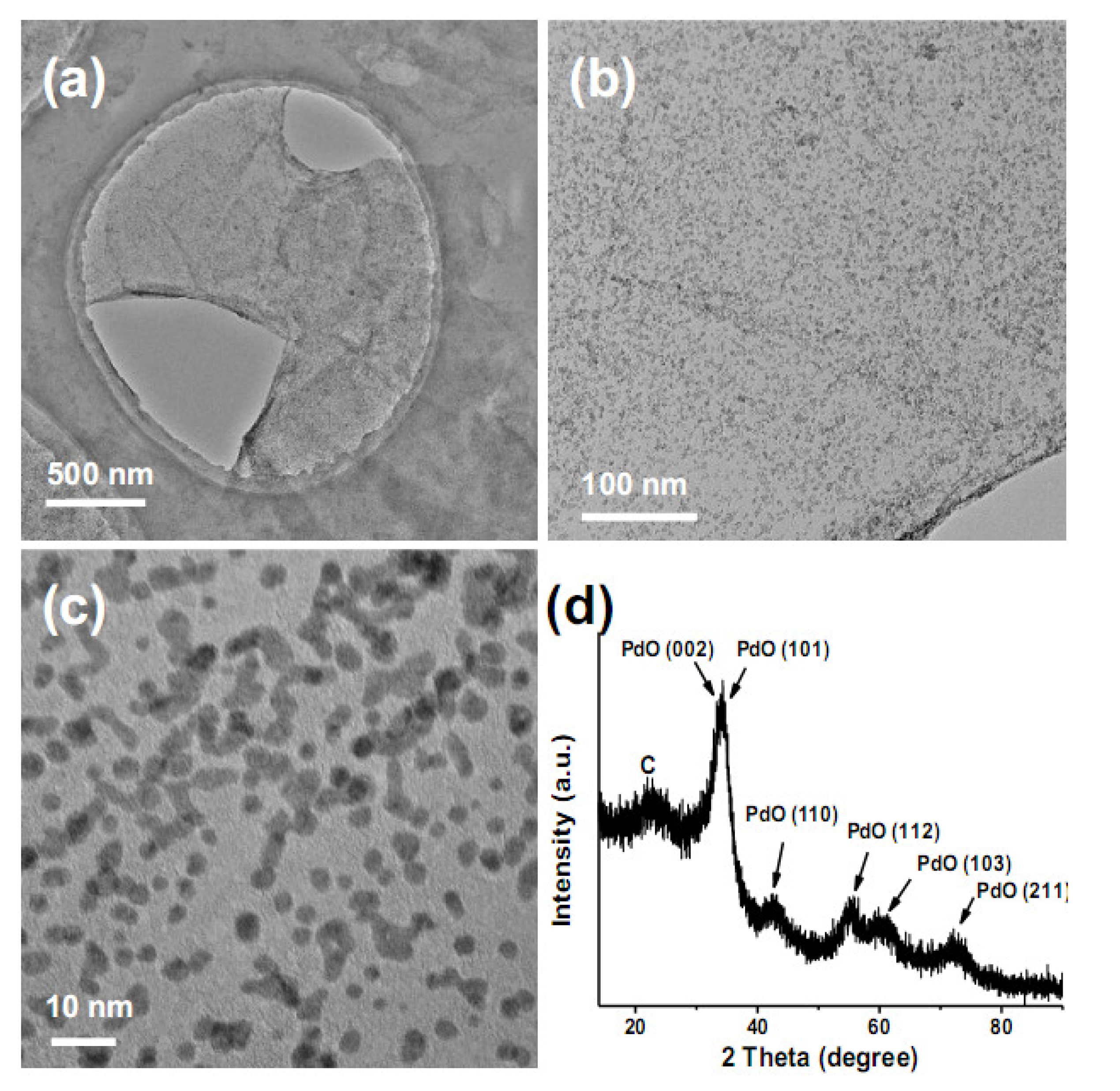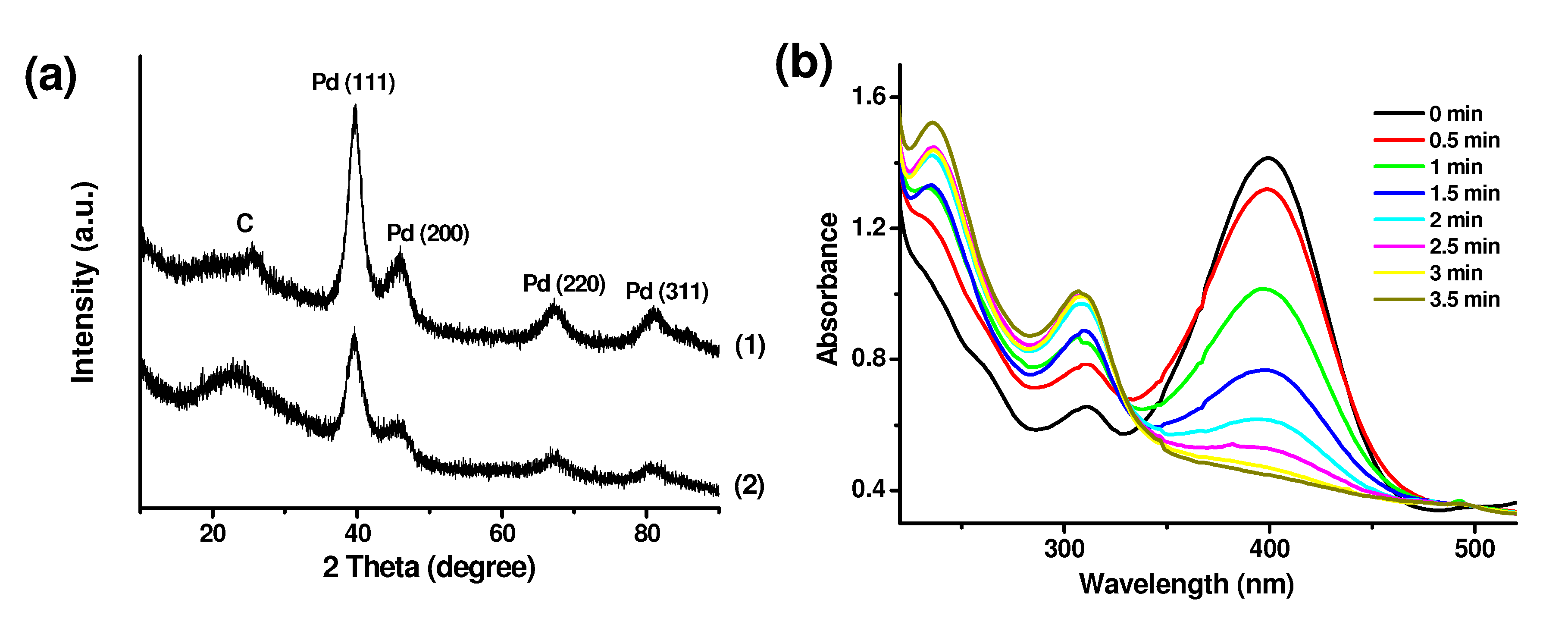A General Strategy for the Preparation of Carbon Nanotubes and Graphene Oxide Decorated with PdO Nanoparticles in Water
Abstract
:1. Introduction
2. Results and Discussion
2.1. Synthesis


2.2. MWCNT/PdO nanohybrids





2.3. MWCNT-g-PAA/PdO nanohybrids

2.4. SWCNT/PdO and DWCNT/PdO nanohybrids

2.5. GO/PdO nanohybrids

2.6. CNT/Pd and GO/Pd nanohybrids

3. Experimental
3.1. Materials
3.2. Characterizations
3.3. Modification of CNTs
3.4. PdO support on CNTs and GO
3.5. CNT/Pd, GO/Pd and catalysis measurements
4. Conclusions
Acknowledgements
References and Notes
- Burda, C.; Chen, X.B.; Narayanan, R.; El-Sayed, M.A. Chemistry and properties of nanocrystals of different shapes. Chem. Rev. 2005, 105, 1025–1102. [Google Scholar] [CrossRef]
- Astruc, D.; Lu, F.; Aranzaes, J.R. Nanoparticles as recyclable catalysts: the frontier between homogeneous and heterogeneous catalysis. Angew. Chem. Int. Ed. 2005, 44, 7852–7872. [Google Scholar] [CrossRef]
- Grunes, J.; Zhu, A.; Somorjai, G.A. Catalysis and nanoscience. Chem. Commun. 2003, 2257–2260. [Google Scholar]
- Zhu, G.H.; Han, J.Y.; Zernlyanov, D.Y.; Ribeiro, F.H. Temperature dependence of the kinetics for the complete oxidation of methane on palladium and palladium oxide. J. Phys. Chem. B 2005, 109, 2331–2337. [Google Scholar]
- Boronin, A.I.; Slavinskaya, E.M.; Danilova, I.G.; Gulyaev, R.V.; Amosov, Y.I.; Kumetsov, P.A.; Polukhina, I.A.; Koscheev, S.V.; Zaikovskii, V.I.; Noskov, A.S. Investigation of palladium interaction with cerium oxide and its state in catalysts for low-temperature CO oxidation. Catal. Today 2009, 144, 201–211. [Google Scholar]
- Oh, S.H.; Hoflund, G.B. Low-temperature catalytic carbon monoxide oxidation over hydrous and anhydrous palladium oxide powders. J. Catal. 2007, 245, 35–44. [Google Scholar]
- Lichtenberger, J.; Lee, D.; Iglesia, E. Catalytic oxidation of methanol on Pd metal and oxide clusters at near-ambient temperatures. Phys. Chem. Chem. Phys. 2007, 9, 4902–4906. [Google Scholar] [CrossRef]
- Wang, K.M.; Huang, T.; Liu, H.F.; Zhao, Y.X.; Liu, H.M.; Sun, C.T. Size control synthesis of palladium oxide nanoparticles by microwave irradiation. Colloids. Surf. A 2008, 325, 21–25. [Google Scholar] [CrossRef]
- Bagchi, V.; Bandyopadhyay, D. In situ generation of palladium oxide nano-crystals. J. Organomet. Chem. 2009, 694, 1259–1262. [Google Scholar] [CrossRef]
- Stakheev, A.Y.; Kustov, L.M. Effects of the support on the morphology and electronic properties of supported metal clusters: Modern concepts and progress in 1990s. Appl. Catal. A 1999, 188, 3–35. [Google Scholar] [CrossRef]
- Simplicio, L.M.T.; Brandao, S.T.; Sales, E.A.; Lietti, L.; Bozon-Verduraz, F. Methane combustion over PdO-alumina catalysts: The effect of palladium precursors. Appl. Catal. B 2006, 63, 9–14. [Google Scholar] [CrossRef]
- Mirkelamoglu, B.; Karakas, G. The role of alkali-metal promotion on CO oxidation over PdO/SnO2 catalysts. Appl. Catal. A 2006, 299, 84–94. [Google Scholar] [CrossRef]
- Okumura, K.; Niwa, M. Regulation of the dispersion of PdO through the interaction with acid sites of zeolite studied by extended X-ray absorption fine structure. J. Phys. Chem. B 2000, 104, 9670–9675. [Google Scholar] [CrossRef]
- Weaver, J.F.; Devarajan, S.P.; Hakanoglu, C. Facile C-H bond cleavage and deep oxidation of propane on a PdO(101) thin film. J. Phys. Chem. C 2009, 113, 9773–9782. [Google Scholar] [CrossRef]
- Demoulin, O.; Le Clef, B.; Navez, M.; Ruiz, P. Combustion of methane, ethane and propane and of mixtures of methane with ethane or propane on Pd/γ-Al2O3 catalysts. Appl. Catal. A 2008, 344, 1–9. [Google Scholar] [CrossRef]
- Wildgoose, G.G.; Banks, C.E.; Compton, R.G. Metal nanopartictes and related materials supported on carbon nanotubes: methods and applications. Small 2006, 2, 182–193. [Google Scholar] [CrossRef]
- Geim, A.K.; Novoselov, K.S. The rise of graphene nature materials. Nature Mater. 2007, 6, 183–191. [Google Scholar] [CrossRef]
- Gao, C.; He, H.; Zhou, L.; Zheng, X.; Zhang, Y. Scalable functional group engineering of carbon nanotubes by improved one-step nitrene chemistry. Chem. Mater. 2009, 21, 360–370. [Google Scholar] [CrossRef]
- Gao, C.; Li, W.W.; Jin, Y.Z.; Kong, H. Facile and large-scale synthesis and characterization of carbon nanotube/silver nanocrystal nanohybrids. Nanotechnology 2006, 17, 2882–2890. [Google Scholar] [CrossRef]
- Jitianu, A.; Cacciaguerra, T.; Benoit, R.; Delpeux, S.; Beguin, F.; Bonnamy, S. Synthesis and characterization of carbon nanotubes–TiO2 nanocomposites. Carbon 2004, 42, 1147–1151. [Google Scholar] [CrossRef]
- Rao, C.N.R.; Sood, A.K.; Subrahmanyam, K.S.; Govindaraj, A. Graphene: the new two-dimensional nanomaterial. Angew. Chem. Int. Ed. 2009, 48, 7752–7777. [Google Scholar] [CrossRef]
- Choi, H.C.; Shim, M.; Bangsaruntip, S.; Dai, H.J. Spontaneous reduction of metal ions on the sidewalls of carbon nanotubes. J. Am. Chem. Soc. 2002, 124, 9058–9059. [Google Scholar] [CrossRef]
- Zheng, M.; Rostovtsev, V.V. Photoinduced charge transfer mediated by DNA-wrapped carbon nanotubes. J. Am. Chem. Soc. 2006, 128, 7702–7703. [Google Scholar] [CrossRef]
- Banks, C.E.; Moore, R.R.; Davies, T.J.; Compton, R.G. Investigation of modified basal plane pyrolytic graphite electrodes: Definitive evidence for the electrocatalytic properties of the ends of carbon nanotubes. Chem. Commun. 2004, 16, 1804–1805. [Google Scholar]
- Ming, Z.; Diner, B.A. Solution redox chemistry of carbon nanotubes. J. Am. Chem. Soc. 2004, 126, 15490–15494. [Google Scholar] [CrossRef]
- Seriani, N.; Pompe, W.; Ciacchi, L.C. Catalytic oxidation activity of Pt3O4 surfaces and thin films. J. Phys. Chem. B. 2006, 110, 14860–14869. [Google Scholar] [CrossRef]
- Hoflund, G.B.; Hagelin, H.A.E.; Weaver, J.F.; Salaita, G.N. ELS and XPS study of Pd/PdO methane oxidation catalysts. Appl. Surf. Sci. 2003, 205, 102–112. [Google Scholar] [CrossRef]
- Brun, M.; Berthet, A.; Bertolini, J.C. XPS, AES and Auger parameter of Pd and PdO. J. Electron. Spectrosc. Relat. Phenom. 1999, 104, 55–60. [Google Scholar] [CrossRef]
- Morales, J.; Espinos, J.P.; Caballero, A.; Gonzalez-Elipe, A.R.; Mejias, J.A. XPS study of interface and ligand effects in supported Cu2O and CuO nanometric particles. J. Phys. Chem. B 2005, 109, 7758–7765. [Google Scholar]
- Yang, D.Q.; Sacher, E. Initial- and final- state effects on metal cluster/substrate interactions, as determined by XPS: Copper clusters on Dow Cyclotene and highly oriented pyrolytic graphite. Appl. Surf. Sci. 2002, 195, 187–195. [Google Scholar] [CrossRef]
- Larichev, Y.V.; Moroz, B.L.; Zaikovskii, V.I.; Yunusov, S.M.; Kalyuzhnaya, E.S.; Shur, V.B.; Bukhtiyarov, V.I. XPS and TEM studies on the role of the support and alkali promoter in Ru/MgO and Ru-Cs+/MgO catalysts for ammonia synthesis. J. Phys. Chem. C 2007, 111, 9427–9436. [Google Scholar]
- Mason, M.G. Electronic structure of supported small metal clusters. Phys. Rev. B 1983, 27, 748–762. [Google Scholar]
- Gabasch, H.; Unterberger, W.; Hayek, K.; Klotzer, B.; Kresse, G.; Klein, C.; Schmid, M.; Varga, P. Growth and decay of the Pd(111)-Pd5O4 surface oxide: Pressure-dependent kinetics and structural aspects. Surf. Sci. 2006, 600, 205–218. [Google Scholar]
- Cimino, S.; Lisi, L.; Pirone, R.; Russo, G. Dual-site Pd/perovskite monolithic catalysts for methane catalytic combustion. Ind. Eng. Chem. Res. 2004, 43, 6670–6679. [Google Scholar] [CrossRef]
- Lai, S.L.; Guo, J.Y.; Petrova, V.; Ramanath, G.; Allen, L.H. Size-dependent melting properties of small tin particles: Nanocalorimetric measurements. Phys. Rev. Lett. 1996, 77, 99–102. [Google Scholar]
- Kong, H.; Luo, P.; Gao, C.; Yan, D. Polyelectrolyte-functionalized multiwalled carbon nanotubes: Preparation, characterization and layer-by-layer self-assembly. Polymer 2005, 46, 2472–2485. [Google Scholar] [CrossRef]
- Pacardo, D.B.; Sethi, M.; Jones, S.E.; Naik, R.R.; Knechtt, M.R. Biomimetic synthesis of Pd nanocatalysts for the stille coupling reaction. ACS Nano 2009, 3, 1288–1296. [Google Scholar]
- Kim, Y.T.; Mitani, T. Oxidation treatment of carbon nanotubes: An essential process in nanocomposite with RuO2 for supercapacitor electrode materials. Appl. Phys. Lett. 2006, 89. Art. no. 033107. [Google Scholar] [CrossRef]
- Shiraishi, M.; Ata, M. Work function of carbon nanotubes. Carbon 2001, 39, 1913–1917. [Google Scholar]
- Forzatti, P.; Groppi, G. Catalytic combustion for the production of energy. Catal. Today 1999, 54, 165–180. [Google Scholar] [CrossRef]
- Shin, J.M.; Kim, H.; Lee, I.S. Synthesis of Fe3O4/PdO heterodimer nanocrystals in silica nanospheres and their controllable transformation into Fe3O4/Pd heterodimers and FePd nanocrystals. Chem. Commun. 2008, 43, 5553–5555. [Google Scholar]
- Esumi, K.; Isono, R.; Yoshimura, T. Preparation of PAMAM- and PPI-metal (silver, platinum, and palladium) nanocomposites and their catalytic activities for reduction of 4-nitrophenol. Langmuir 2004, 20, 237–243. [Google Scholar] [CrossRef]
- Tung, V.C.; Allen, M.J.; Yang, Y.; Kaner, R.B. High-throughput solution processing of large-scale graphene. Nature Nanotech. 2009, 4, 25–29. [Google Scholar] [CrossRef]
- Gao, C.; Vo, C.D.; Jin, Y.Z.; Li, W.W.; Armes, S.P. Multihydroxy polymer-functionalized carbon nanotubes: synthesis, derivatization, and metal loading. Macromolecules 2005, 38, 8634–8648. [Google Scholar] [CrossRef]
- Sample Availability: Contact the authors.
© 2010 by the authors; licensee MDPI, Basel, Switzerland. This article is an Open Access article distributed under the terms and conditions of the Creative Commons Attribution license (http://creativecommons.org/licenses/by/3.0/).
Share and Cite
He, H.; Gao, C. A General Strategy for the Preparation of Carbon Nanotubes and Graphene Oxide Decorated with PdO Nanoparticles in Water. Molecules 2010, 15, 4679-4694. https://doi.org/10.3390/molecules15074679
He H, Gao C. A General Strategy for the Preparation of Carbon Nanotubes and Graphene Oxide Decorated with PdO Nanoparticles in Water. Molecules. 2010; 15(7):4679-4694. https://doi.org/10.3390/molecules15074679
Chicago/Turabian StyleHe, Hongkun, and Chao Gao. 2010. "A General Strategy for the Preparation of Carbon Nanotubes and Graphene Oxide Decorated with PdO Nanoparticles in Water" Molecules 15, no. 7: 4679-4694. https://doi.org/10.3390/molecules15074679



